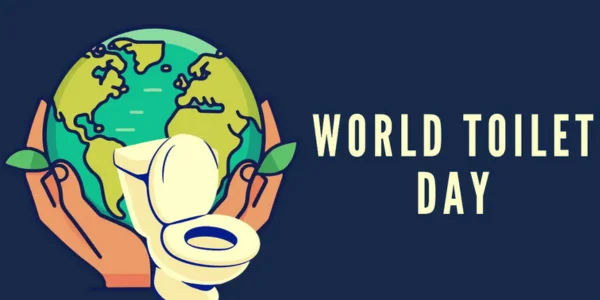Observed annually on November 19, World Toilet Day highlights the importance of safe sanitation and raises awareness about the global sanitation crisis. Established by the United Nations in 2013, this day is an opportunity to advocate for actions to tackle the lack of access to toilets, a pressing issue that affects millions worldwide. The day also supports the Sustainable Development Goal (SDG) 6, which aims to ensure access to water and sanitation for all by 2030.
Here’s an in-depth look at the history, significance, and global efforts surrounding World Toilet Day.
History and Origins

World Toilet Day was first established by the World Toilet Organization in 2001 as a global campaign to break the taboo around toilets and sanitation. Recognizing the need for broader support, the United Nations General Assembly officially declared November 19 as World Toilet Day in 2013 through Resolution A/67/291.
The date was chosen to focus attention on a critical global issue often overlooked: the lack of access to basic sanitation facilities, which poses risks to health, dignity, and economic development.
Significance of World Toilet Day
Toilets are a fundamental human necessity, yet approximately 3.6 billion people—nearly half the global population—live without access to safe sanitation. This has far-reaching implications:
- Health Impact: Poor sanitation contributes to diseases like diarrhea, cholera, and intestinal worms. According to the World Health Organization (WHO), over 500,000 deaths annually are linked to poor sanitation and unsafe water.
- Gender Inequality: Women and girls are disproportionately affected by the lack of safe toilets, leading to challenges in maintaining hygiene, especially during menstruation. Inadequate sanitation also increases their vulnerability to harassment and violence.
- Environmental Degradation: Improper disposal of human waste contaminates water bodies, harming ecosystems and contributing to waterborne diseases.
- Economic Loss: The lack of sanitation costs the global economy an estimated $260 billion annually due to health-related expenses and lost productivity.
World Toilet Day serves as a platform to address these challenges and advocate for sustainable solutions.
Themes of World Toilet Day
Each year, World Toilet Day adopts a theme that focuses on a specific aspect of sanitation. These themes align with SDG 6, which aims to ensure sustainable water and sanitation management. Recent themes include:
- 2022: “Making the Invisible Visible,” focusing on the link between sanitation and groundwater.
- 2021: “Valuing Toilets,” emphasizing the essential role of toilets in public health, safety, and dignity.
- 2020: “Sustainable Sanitation and Climate Change,” highlighting the impact of climate change on sanitation systems.
These themes underscore the need for innovative and context-specific approaches to improving sanitation.
The Global Sanitation Crisis
Despite progress, the global sanitation crisis remains a significant challenge:
- Open Defecation: Over 494 million people still practice open defecation, leading to health risks and environmental pollution.
- Rural Disparities: Rural communities face greater challenges, with fewer resources and infrastructure to build safe sanitation systems.
- Climate Vulnerability: Floods, droughts, and rising sea levels exacerbate the sanitation crisis, damaging toilets and contaminating water supplies.
Addressing these issues requires collective action from governments, organizations, and individuals.
Global Efforts to Improve Sanitation
The observance of World Toilet Day aligns with international efforts to tackle the sanitation crisis:
- Sustainable Development Goal 6: Specifically, Target 6.2 aims to achieve access to adequate and equitable sanitation and hygiene for all, with a focus on women, girls, and vulnerable populations.
- UN-Water Initiatives: UN-Water coordinates efforts to support countries in achieving sanitation targets, including capacity building and knowledge sharing.
- Community-Led Total Sanitation (CLTS): This approach focuses on empowering communities to end open defecation and improve sanitation practices.
- Innovative Solutions: Organizations are developing cost-effective, eco-friendly toilets and waste management systems tailored to local needs.
How World Toilet Day is Observed
World Toilet Day is marked by a variety of activities and initiatives aimed at raising awareness and driving action:
- Public Awareness Campaigns: Governments and NGOs organize campaigns to educate communities about the importance of sanitation and hygiene.
- Community Engagement: Grassroots efforts include constructing toilets, improving waste management, and encouraging behavior change.
- Policy Advocacy: Discussions and forums highlight the need for increased funding and stronger policies to address sanitation challenges.
- Educational Programs: Schools and universities host workshops and events to teach children and young adults about the significance of sanitation.
The Role of Innovation in Sanitation
Technology and innovation play a pivotal role in addressing the sanitation crisis. Examples include:
- Waterless Toilets: Innovations like composting toilets offer sustainable solutions in water-scarce areas.
- Sanitation as a Resource: Systems that convert waste into biogas or fertilizers promote a circular economy.
- Digital Monitoring: Tools like mobile apps track sanitation coverage and identify areas in need of intervention.
Such advancements are critical for achieving universal access to sanitation.
How You Can Contribute
Individuals can play a vital role in supporting World Toilet Day and improving global sanitation:
- Advocate for Change: Raise awareness about the importance of sanitation through social media and community events.
- Support Local Initiatives: Volunteer with organizations working to build toilets and improve sanitation facilities in underserved areas.
- Adopt Sustainable Practices: Use water responsibly and promote eco-friendly waste management solutions.
- Educate Others: Spread knowledge about the health and environmental benefits of proper sanitation.
Looking Ahead: Achieving SDG 6
The path to achieving universal sanitation by 2030 requires sustained effort and collaboration. Governments must prioritize investments in sanitation infrastructure, while organizations and communities must work together to ensure equitable access. With the collective will of global citizens, we can turn the vision of safe sanitation for all into a reality.
Conclusion
World Toilet Day is more than a day of observance; it is a call to action. It reminds us that access to toilets is a basic human right and a cornerstone of public health, dignity, and sustainable development. As we commemorate this day, let us commit to breaking the stigma around sanitation, advocating for innovative solutions, and ensuring that no one is left behind in the journey toward universal access to safe toilets. Together, we can create a world where everyone has the sanitation they deserve.

